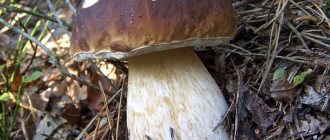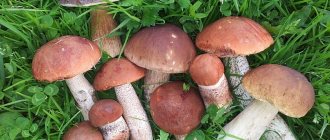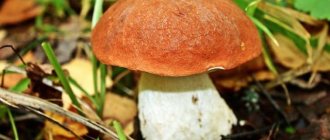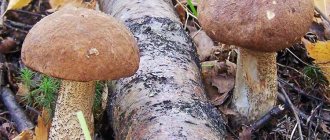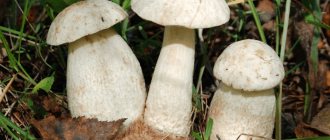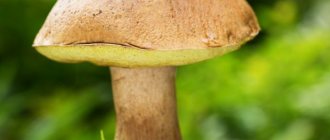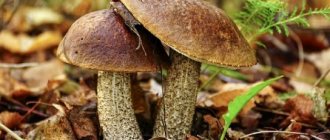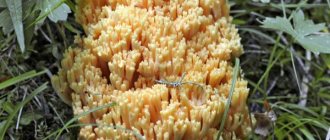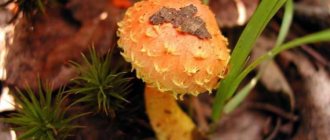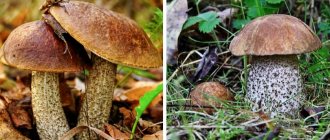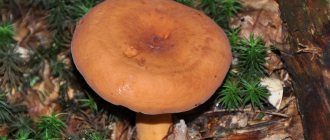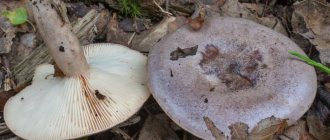One of the favorite and most recognizable mushrooms is boletus. Its bright cap is reminiscent of autumn foliage and can be any shade from beige to bright red. This mushroom is easy to find among green grass. But it is important to know that there are several varieties of boletus mushrooms, including the false aspen mushroom. This is not some independent type of mushroom culture, but several representatives.
What does a boletus look like?
Despite the diversity of species, boletuses (or red mushrooms, red mushrooms, etc.) are distinguished by their massiveness, elastic stem, bright cap and dense consistency of the fruiting body. The diameter of the cap varies between 5-20 cm. Sometimes you come across real giants - about 30 cm.
Young boletuses
If the mushroom is young, then its cap has a hemispherical shape. It wraps the leg tightly. With age, it becomes convex, pillow-shaped, and then completely straightens.
The skin is usually impossible to remove. It is dry to the touch, sometimes velvety. The leg is club-shaped (thick at the bottom, thin at the top). It grows up to 22 cm. The leg itself is light, but covered with numerous dark scales.
Tubular layer of boletus
The spore-bearing layer of boletus is tubular. Its thickness is about 1-3 cm. The color is usually white, yellow, gray or brownish. The spore powder is brown or olive-brown in color.
The cap flesh is dense, elastic and fleshy. The stalk is characterized by a longitudinal arrangement of fibers. The pulp is white, but if damaged it quickly turns blue, and, after some time, turns black.
Boletus
Boletus (Latin name - Leccinum) is one of the most attractive representatives of the higher fungi of the class of basidomycetes. Lovers of quiet hunting highly value the boletus and are always happy to meet it in the forest. Bright, handsome redheads are noticeable from afar, even in thick grass or among fallen leaves. The popular names for boletus are obabok, redhead, aspen mushroom, aspen mushroom.
The bright boletus mushroom with a velvety round cap in red, ocher and brown-chocolate shades cannot but please the eye and serves as a real gift for an experienced mushroom picker and for a beginner. Another undoubted advantage of boletus mushrooms is the absence of poisonous and inedible mushrooms among the varieties. There are also no false boletuses. As a rule, even beginners know very well what kind of mushrooms are boletus. After all, it is almost impossible to confuse the redhead with a dangerous mushroom.
Biological classification and description of boletuses
Boletus mushrooms are the name given to several species of mushrooms of the genus Lecinum (boletus), which also includes boletus mushrooms (Boletaceae family). These species are distinguished by a porous (tubular) hymenophore. In addition to mushrooms of the obabok genus (boletus and boletus), this includes boletuses, moss mushrooms and other genera of mushrooms with a cap-shaped type of fruiting body.
In the kingdom of mushrooms, boletus (boletus, aspen, redhead) belongs to the department of real mushrooms - macromycetes.
Class – basidomycetes, subclass – homobasidal.
Group – Hymenomycetes, order – Agaricaceae – tubular.
What boletuses look like: photo and description
Descriptions of the boletus mushroom found in reference books note the following characteristic features:
- Red, orange, red-brown cap in the shape of a hemisphere;
- Thick, stable leg, rough to the touch;
- the body of the fungus quickly oxidizes in air - the fracture site first turns blue-green and then darkens. .
The boletus cap is hemispherical or convex-cushion-shaped, has a smooth or velvety coating, and is covered below with a porous hymenophore. In young mushrooms, the cap tightly adheres to the stem, and the hymenform is white or cream-colored and practically inseparable from the body of the mushroom. In mature (more than 7-10 days) redheads, the cap grows to 15-30 cm in diameter, takes on a convex-prostrate shape with a well-separable hymenform of beige or gray color. The tubular layer is 1-3 cm, with the development of the fungus it becomes looser and darkens when touched.
The leg of the red-headed boletus has a club-shaped or cylindrical shape and is covered with black, brown or gray scales, elastic and juicy in young mushrooms, and fibrous in mature ones.
The pulp of the crosshead is dense and fleshy. A characteristic feature of boletuses is the change in color of the mushroom when cut from white to blue, and then black. When cooked, the flesh turns black.
Boletus spore powder is yellowish-brown in color.
Where does the boletus grow?
You can collect boletus mushrooms in deciduous and mixed forests under young trees, in deciduous sparse forests or aspen forests. Boletuses grow in sparse groups or singly. Boletus grows throughout the forest belt of Eurasia, in the tundra, in the Far East, in the Caucasus and in the foothills of the Urals. Despite their name, boletuses form a symbiotic partnership - mycorrhizae - not only with aspens, but also with many deciduous and coniferous tree species. Different subspecies of redheads can be found near birch, oak, pine, spruce, oak and poplar trees. The color of the boletus cap depends on the tree under which it grows. Under poplars there are white boletuses, under aspens – red, under birches – yellow-brown.
Aspen trees usually grow in groups or individually in birch forests, aspen forests, pine forests or mixed forests. The first redheads, depending on the temperature and soil moisture, grow in the middle or end of June and appear with varying degrees of activity until the first autumn frosts. Based on the time of active growth of boletuses, three streams are distinguished:
- “spike boletuses” – the earliest June boletuses;
- “Reapers” – later (July – August);
- “deciduous” - the time of fruiting for these boletuses begins in September and continues until frost.
Some varieties of boletus mushroom. Photo
- Red boletus, red-headed boletus (lat. Leccinum aurantiacum) - grows everywhere from mid-June until frost without a clear preference for mycorrhizal partnerships. It can be found under a wide variety of tree species, but most often you can find this boletus under aspen and in mixed forests.
- Yellow-brown boletus, or aspen boletus (Leccinum versipelle) grows in birch forests, mixed light forests, and less often in pine forests. Large mushrooms with bright orange or yellow-brown caps, which when opened reach 25-30 cm. Young, unopened mushrooms may have small strips of dried skin hanging along the edges of the cap. This mushroom is more reminiscent of boletus in shape than other boletuses.
- White aspen boletus (Leccinum percandidum) does not look quite the same as ordinary boletus. White boletus is a mushroom with a white and later gray-brown cap, growing up to 25 cm and a cream-colored stem. They are distinguished from boletus mushrooms by the presence of pronounced scales on the stem and blue flesh on the cut of the mushroom.
- Black-scaled boletus (Leccinum atrostipiatum) is a relatively small mushroom with a cap, 5-12 cm in diameter. When cut, it quickly turns blue with a transition to dark purple and then black.
- Redhead pine (Leccinum vulpinum) is a variety of boletus with a dark crimson velvety cap and brown scales on the stem. Forms mycorrhiza with bearberry and pine trees.
- The spruce redhead (Leccinum piceinum) has a dark chestnut cap and a low, cylindrical, brownish stem. Prefers sparse spruce forests or mixed woodlands with sandy soils. This boletus is quite small - a tight-fitting hemispherical cap with a diameter of 3 cm, when opened - no more than 10 cm.
- The colored-legged boletus (Tylopilus chromapes, or Leccinum chromapes) is easily distinguished from other species by the pinkish-brown scales on the stalk, which acquires a bright ocher color at the base. The shape of the cap is flatter than that of other representatives of boletuses and when ripe it becomes almost concave. When cut, the flesh initially has a pinkish tint, then turns blue.
Useful properties and nutritional value of boletus
Boletus is a valuable edible mushroom with excellent taste. In terms of the content of nutrients, vitamins and useful microelements, it belongs to mushrooms of the second food category, second only to boletus, milk mushrooms and saffron milk caps. At the same time, taking into account all the undeniable advantages, many put it in second place after white.
In addition to water (up to 90%), aspen boletuses contain carbohydrates, proteins, fiber, vitamins A, B, C and valuable microelements: iron, potassium, magnesium, calcium, phosphorus, sodium.
It is recommended to boil, stew and fry redheads. You can cook boletus as an independent dish or use it as a healthy and flavorful addition to meat, fish or vegetarian dishes. For the winter, you can make boletus preparations using all the traditional methods for mushrooms.
- Dried boletus retains all useful microelements and is suitable for making soups, pies, and mushroom sauces. Dried boletuses in their finished form are very compact, take up little space in the closet and are perfectly stored if normal indoor humidity is maintained at room temperature. Before drying, mushrooms should be cleaned, wiped with a napkin, cut and dried in several steps in an oven, electric dryer or dry, well-ventilated room, after spreading them in a thin layer on paper.
- Frozen boletus retains all of the listed useful elements, is a semi-finished product for all kinds of mushroom dishes and requires a minimum of time for preparation. Peeled mushrooms should be wiped with a damp cloth (do not wash!), cut and placed in small portions in containers or bags for further quick freezing in the freezer. In order for the mushrooms to take up less space, they can be pre-boiled (no more than -7-5 minutes) and drained.
- Pickled boletus is the only way to preserve the white color of the mushroom pulp. During processing, the flesh of boletus usually darkens, but in the marinade it retains its natural appearance. To do this, they must first be soaked in a 0.5% citric acid solution.
Recipe for pickled boletus
For 1 kg of boletus 20 g of salt, 50 ml of acetic acid, 1 glass of water, 10 black peppercorns and 5 allspice, 2-3 bay leaves, ½ tsp. Sahara.
Cut clean aspen boletuses, previously soaked in a weak lemon solution, and boil in salted water for 8 minutes. Then, add the prepared seasonings and cook until the mushrooms sink to the bottom of the pan. Add vinegar at the very end of cooking. Place in sterilized hot jars and sterilize before sealing.
Why is the boletus called that?
The Latin name for the genus of mushrooms is Leccinum (they also include boletus mushrooms). Boletus got its name by analogy with boletus - due to the ability of the fungus to form stable mycorrhiza with aspen. However, its different species also grow near other trees.
Interesting: The most popular conditionally edible mushrooms: list, names, photos and videos
Mature boletus
Other names for the mushroom:
- aspen;
- red mushroom;
- redhead;
- obabok;
- chelysh.
The remaining names were assigned to the boletus for its characteristic appearance - a red cap and its shades.
Why does the boletus darken when cut?
All boletuses have white flesh, but if the fruiting body is damaged, it turns blue, purple, or black. Only isolated spots may appear on the pulp, or the entire inner surface may darken.
Boletus cut
This phenomenon is not dangerous, although it spoils the appetizing appearance of the little guy. The fact is that it contains a special substance - variegated acid. When the integrity of the pulp is compromised, the process of interaction of this acid with air begins. Oxidation occurs to form quinomethide anion with a blue hue.
The darkening of the mushroom pulp is similar to the oxidation of some vegetables and fruits, which also change color. In its pure form, the pigment oxidizes more slowly, therefore, red mushrooms contain substances that accelerate this process.
False boletus
In addition to the fact that boletuses are one of the most beautiful, tasty and healthy mushrooms, they are also one of the safest forest gifts.
Despite the impressive number of varieties, these mushrooms are practically never poisonous. But novice mushroom pickers still often wonder what a false aspen boletus looks like. However, more experienced ones assure: there are no false redheads in nature. The only problem is that, due to inexperience, some people mistake bitterling (gall mushroom) for boletus. You can identify “false boletus” by the characteristic brown mesh on the stem (instead of scales), pink or brown spots on the cut, and a bitter taste.
Where and when do boletuses grow?
Boletus is considered one of the most common mushrooms. It grows in the temperate zone of Eurasia and North America. Each species has a tree species that is most suitable for it.
Therefore, boletuses grow near oaks, birches, willows, poplars, spruces, and not just under aspens. Most often they grow in groups, but sometimes there are also “loners”. Optimal conditions for them are conditions with high humidity - forests and bushes, where there is a lot of shade.
Many boletuses in a pine forest
The growth time is also determined by the species. Boletuses are divided into 3 categories depending on when they grow:
- spikelets;
- reapers;
- deciduous plants.
The first mushrooms, spikelets, appear at the end of June, but usually there are not many of them. These include species such as white and yellow-brown boletus. The peak of growth occurs in July-August - you can count on an abundance of stubble mushrooms. These are oak boletus, black-scaled and red boletus.
Interesting: Mushrooms - list, types, names, description, where they grow, photos and videos
Boletuses on coniferous litter
By the way, species that grow under deciduous trees love warmth, so it is best to collect them in summer and early autumn. The same species that form symbioses with conifers can bear fruit before the first low temperatures in October.
This is explained by the fact that coniferous litter protects the mycelium from low temperatures for a long time. Deciduous species include pine and spruce.
How long does the boletus grow? When to collect?
Boletuses occupy a leading place in terms of growth rate. For example, a mushroom can grow a couple of centimeters in a day. Weather conditions affect the growth rate of boletuses.
Stages of boletus growth - from the youngest to the most mature mushroom
After a heavy rain within a day, they become quite impressive in size, since they quickly absorb moisture from the soil and all useful substances. By the way, the absorption of harmful substances by mushrooms also occurs, so it is very important to collect them only in environmentally friendly areas.
Interesting fact : the lifespan of mycelium (mycelium) reaches 80 years. In order for boletuses to grow in the same place repeatedly, they should be collected carefully.
If it rains frequently, then the collection of redheads can continue throughout the summer and autumn until it gets colder. After the rain, just wait a day - the mushrooms will already have reached the desired size. If cold weather persists, the red mushroom takes 3-4 days to reach its optimal size.
Red
A variety of boletus that can form mycorrhiza with different species (deciduous). The sizes of mushrooms are different - the caps are from 4 to 15 cm, sometimes more. The legs are tall (up to 15 cm), massive (1.5-5 cm).
Red boletus
Possible red, red, red-brown color of the cap. The skin fits tightly to the cap, does not need to be cleaned, and has a velvety feel to the touch. The light leg is covered with darker scales. The flesh is white, turning blue at the break. The species is widespread, grows in warm weather - June-October.
Interesting: The earliest edible mushrooms - list, description, photo and video
Paintedfoot
It stands out noticeably from others in appearance. It has a large convex or almost flat cap of a pink-brown hue. The leg is creamy pink, covered with red or pink scales.
Painted-legged boletus
At the very base it turns yellow. The colored-legged boletus begins to bear fruit at the end of May and ends in August. Grows with both deciduous and coniferous trees.
Interesting fact : for some reason, this particular species attracts insects, so very often the mushrooms you come across are wormy.
Yellow-brown (red-brown)
Distributed near birch, aspen and mixed forests. The cap is large, like other species, and the leg is even taller and thicker (up to 22 cm in height, up to 4 cm in thickness). The characteristic color for this species is yellow-brown or yellow-orange.
Yellow-brown boletus
The skin feels dry and often protrudes beyond the cap. The leg is gray or white, densely covered with small scales that darken with age. The yellow-brown species often grows alone than in a group.
The initially white pulp changes color several times when cut. First it is pink, then blue (tints purple). The flesh of the leg may turn greenish. Mushrooms are collected from early summer to autumn, but occasionally they bear fruit in cool conditions.
Interesting: Mushrooms: what are they useful for, description, photos and videos
Types of boletuses and their description with photos
Boletuses include many species that have their own distinctive features both in size and color. A description of the species of the genus Leccinum is presented below.
Red aspen or red aspen
The appearance of the redfish changes as it matures. At the first stages of growth, his hat looks like a hemisphere, a little later it looks like a pillow, and at the very end of maturation it becomes convex upward. The color of the tubular layer also changes during growth: if at first it is white, it later acquires an ocher color.
The diameter of the hat, as a rule, ranges from 7-18 cm. The color of the hat is closely related to the location of germination. In forests where poplar trees predominate, the bright color of the cap has a slight gray tint, while near aspen the cap is predominantly dark red.
The pulp is dense, fibrous, white. The leg is covered with scales that change color from white to brown. The length of the leg can reach 18 cm, and the width - 4 cm. It does not have a pronounced smell or taste. It likes to grow next to aspen, poplar, oak and birch, but this species does not grow next to coniferous trees.
Red or yellow-brown
Another name for the species is Obabok variegated. The largest boletus, distinguished not only by its “stocky body”, but also by the height of its legs. The height and width of the leg is 22 by 7 cm. The scales are small, from brown to black.
The shape of the hat resembles a hemisphere, covered with dry, matte skin with a slight velvety feel. The diameter of the cap is 25 cm, it can be yellow or brown. As it matures, the color seems to fade, and the hat acquires ocher shades. The pulp, like that of most redheads, is dense and white; when cut, it turns purple or blue with a green tint in the stem. This species can most often be found under birch trees.
White boletus
This mushroom is a rare species and is listed in the Red Book. The main feature of this species is the color of its hat. Unlike its brightly colored relatives, this aspen tree is completely white, which is how it got its name. The skin of the hat changes under the influence of moisture, during rains it becomes covered with mucus, and in dry seasons it is always dry and smooth.
The tubular layer is light, becoming gray as it grows. The shape of the hat is similar to the shape of a multi-skinned obobka. Quite large, the diameter of its hat reaches an average of 12 cm, but under favorable climatic conditions it can reach 25 cm. Height - 15 cm. Leg girth - 1-2 cm. There are dark, almost black scales on the leg.
Oak obabok
It is practically no different from the red or yellow-brown species. The only distinctive features include the chestnut-brown color of the cap and the almost cylindrical shape of the stem, which only slightly thickens at the bottom.
Scales are brown-red. The flesh is mostly white, but may contain a small amount of gray or almost black veins. It grows mainly near oak trees.
Redhead pine
It has a rather high leg (up to 18 cm), covered with brown scales. The color of the hat is brown with an orange tint.
As it grows, the tubular layer changes color from white to light brown with a grayish tint. The cut is painted purple-gray. Place of growth - pine forests.
Painted-legged aspen
This species differs from its relatives in having a small pink cap and light pinkish-yellow scales on the leg.
The leg is smooth, shaped like a cylinder. The tubular layer is angular, pink with a bronze tint.
Pine
Pine redhead creates mycorrhizae with pine trees and the bush plant bearberry. The cap is convex or flat, up to 15 cm. Its distinctive feature is considered to be a red-brown shade with a clearly visible pink tint.
Pine boletus
The leg grows up to 15 cm with a thickness of 4-5 cm. It also has brown scales. Like the red mushroom, the flesh of the pine one turns blue and then turns black when broken.
Based on the name, this species is common among coniferous varieties, especially pine. It requires moisture, dampness, and a minimum of light. It is easy to confuse it with the red boletus and is the second most common species.
Spruce
Almost no different from pine, but this species has a bright chestnut-brown cap. Also, it usually does not grow to gigantic sizes - the diameter of the cap is from 3 to 10 cm, and the leg is no more than 14 cm in height and 3 cm in thickness.
Spruce boletus
There are many small dark scales on the brownish stem. The flesh darkens in spots when cut. The skin is velvety, sometimes protruding beyond the edges. Spruce redheads are collected in the period July-September among coniferous and mixed forests. They grow in groups.
Description of edible mushroom
Red boletus is also called ordinary, blood-red or red-crimson; you can also find synonyms such as Krasyuk, Krasnik or simply Aspen. Its Latin name is Leccinum aurantiacum or Boletus sanguinescens. Belongs to the genus of the boletaceae family.
The mushroom cap, as a rule, does not exceed 15 cm in diameter. In young fruits it is hemispherical, the edge is always tightly attached to the stem. Then it becomes cushion-shaped, convex and easily separated from the fruiting body. The surface skin is red or orange, maybe with a brown tint. Smooth or slightly velvety, not removable.
The tubular hymenophore is the name given to the lower part of the cap. Its color is white, later turning brown, sometimes with a gray tint, olive or yellow. The tubes can be up to 3 cm long, angular, and darken when pressed or touched. The spores are olive-brown.
The flesh is very fleshy, quite dense, and elastic in the cap. As it gets older it becomes softer. The leg has a fibrous structure. When cut, the color is white, but quickly turns blue and later black. Taste and aroma are not expressed.
The leg reaches a height of 15 cm, and a diameter of up to 5 cm. It expands at the bottom and is dense. The surface is white with gray tones, completely covered with scales arranged longitudinally in the form of fibers. In young redheads they are white, later turning brown.
This species is becoming less and less every year, in many regions of Russia its population is decreasing, but so far only its relative, the white boletus, is listed in the Red Book, and the red one is not.
A little history
The first to mention the redhead was the French doctor and botanist Jean Baptiste François Pierre Bulliard. The description was finalized and assigned to the genus in which this boletus is still listed to this day by the Briton Samuel Frederick Gray. A pharmacologist, botanist and chemist by training, he did this back in 1821.
Blackscale
Mushroom with an orange-red, brick or dark red cap. In young boletuses it is velvety, and in mature ones it is smooth. At first the cap is semicircular, and then becomes cushion-shaped.
Black-scaled boletus
The average size is about 8 cm. The leg grows up to 18 cm. The scales are dark, almost black. The white flesh quickly turns purple and then bluish-black.
False boletus - how to distinguish?
There is no independent false boletus as a separate species. However, the edible species is often confused with another mushroom - bitterling, also known as gall mushroom. It has a very bitter taste.
Interesting: Why do boletus paint your hands?
Gorchak looks attractive, because due to its specific taste, insects and animals practically do not eat it. It is dangerous for our body in large quantities, but in general it is considered simply inedible. Gall fungus grows everywhere.
Gall mushroom (gorchak)
How to distinguish bittersweet from edible boletus:
- Leg. All edible redheads have a light-colored stalk with small scales. In the gall fungus it is covered with a mesh.
- Hat. Gorchaki are characterized by a smooth cap of yellowish, light brown color with a greenish tint. The tubular layer is cream or dirty pink. Boletus caps are reddish, with the exception of the white variety.
- Pulp. The white flesh of the gall fungus turns pink when cut, and that of the obabka turns blue or dark.
Obabok has no other inedible or poisonous counterparts, so it is excellent even for inexperienced mushroom pickers. The mushroom can only be confused with the edible boletus.
False doubles
The red boletus has no similar counterparts. It is easy to distinguish it from other mushrooms; it stands out not only for its appearance, but also for its size. The only fruit that can very vaguely resemble redhead to an inexperienced mushroom picker is mustard or gall mushroom. It is very easy to distinguish them - the bitterling has predominantly yellow shades of the cap and stem, and the boletus has a bright cap and a white stem with dark inclusions.
Bile mushroom
Useful properties, vitamins, minerals
Boletus contains vitamins B, A, C, PP in significant quantities. There are also amino acids and useful minerals, for example: potassium, calcium, sodium, magnesium, phosphorus, iron. Broth based on these mushrooms is useful.
“Classic” boletus growing under an aspen
Eating it helps boost immunity and remove toxins from the body. In terms of its richness in nutrients, mushroom broth is compared to beef broth.
Interesting fact : 100 grams of boletus contains 4% protein, 1% fat, 2% fiber, 1.5% carbohydrates.
The benefit of the mushroom also lies in its high protein content, which is well absorbed in the body. It is 90% water, like many other species. Accordingly, the calorie content of the mushroom is only 22 kcal per 100 g, which makes it suitable for dietary nutrition.
Collection time
The boletus is very beautiful, and it is always a great joy to find it. The first mushrooms begin to appear in mid-June and can be found until October if there is no frost. Boletuses contain proteins, fiber, carbohydrates, minerals, and fats. They contain a lot of potassium, iron and phosphorus, as well as vitamins A, C, PP and group B. In terms of vitamin B content, boletuses are in no way inferior to grain crops, and in terms of vitamin PP content - to liver and yeast. Boletuses have a lot of proteins (more than meat). Boletuses also contain many valuable amino acids, which are essential in restoring a weakened body, which is why these mushrooms are recommended for use by people who have suffered infectious diseases, surgeries, or inflammatory diseases.
Storage conditions
The boletus mushroom is in no way inferior to the boletus mushroom in its taste and nutritional properties; rather, it shares the second place of honor with it after the porcini mushroom. Boletuses are boiled, fried, dried, pickled, salted, using both the cap and the stem (although some consider it a bit harsh). During processing, Boletus, as a rule, darkens, only in the marinade does it retain its natural appearance.
Drying
Clear the boletuses from twigs, grass and soil. Boletus mushrooms must not be washed before drying! Mushrooms take on water very quickly, and washed mushrooms cannot be dried. Small boletuses are dried whole, large ones are cut, but not finely. It is best to dry on a thread or in the oven. The oven temperature should be set at 50-60 degrees - this is the minimum available mode and the door is slightly open. Some oven models will require you to open the door completely due to the inability to lower the temperature. Dry the mushrooms on a baking sheet lined with parchment. Place on the top shelf.
Damage to boletus
Despite their nutritional value, eating mushrooms should be taken seriously. Like any other mushroom, this species is considered “difficult” to digest; mushroom dishes should not be overused.
Interesting: White mushroom
